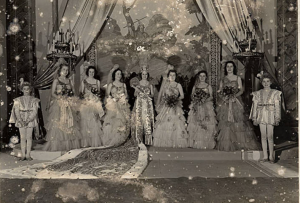
The Mardi Gras queen represents the epitome of Southern white femininity, as a Southern Belle elevated to the level of royalty. John Teunisson’s photograph of the Hermes Mardi Gras Court from the early 1900s features the Mardi Gras krewe’s queen arrayed in all her royal regalia with three maids and a young males page flanking her on either side. The queen stands at the center of the photograph and is flanked on either side by three of her maids and two young male pages. She and her court stand atop a slightly elevated stage, her ornately embroidered white dress finishing in a long train that cascades down the steps into the foreground of the image. Behind them, an enormous painting surrounded by an ornate frame festooned by two large satin drapes showcases a knight brandishing his sword on the back of a dragon, reminding the room that men are the ones controlling power, perhaps even alluding to the knights of the Ku Klux Klan. On either side of the painting, two raised candelabras contain dozens of candles, illuminating the room with a warm glow. The combined effect of all of these elements makes the room itself feel like the throne room of an imaginary castle, giving the viewer a glimpse into the supposed world of Southern royalty.
Probably taken between 1901 and 1920, this undated image comes from a large collection of photographs donated by the photographer, John Norris Teunisson in the mid-1920s to the Louisiana State Museum.[1] Originally an insurance inspector, Teunisson first advertized his photographic services in 1901 and gained a reputation for photographing a wide range of public events in New Orleans including parades, celebrations, private dinners, and Mardi Gras balls.[2]
A 1953 article in the New Orleans Times-Picayune entitled, “There’ll always be a Southern Belle” describes the attributes of “the most formidable mantrap in the world – the southern belle”.[3] The author of the article Bern Keating, bases his claim to authority on the fact that he is married to a Southern Belle and that his daughter will become one, and states that a southern girl “dresses for men”, “thinks of men”, and “plays for men” and “for the Southern Belle, all life leads to the wedding day”.[4] In this case, men are the creators of the image and attitudes central to the notion of the Southern Belle. It comes as no surprise then, that men created the idea of the Southern Belle to further their own social and political agendas.
The notion of the Southern Belle, born out of the need for a central figure to represent the Old South, played an important role during the Civil War, Reconstruction, and even throughout the 20th century. In Reconstructing Dixie, Tara McPherson discusses the need for a southern figure to represent the South and how it was “the southern lady as a central player in the aggrandizement of Dixie, a figure who, along with her younger counterpart, the belle, served as a linchpin of nineteenth century revisionist versions of the Old South.”[5] Therefore, the Southern Belle had to embody the ideals of the white, southern elite and helped redefine the hierarchy of the post-civil war divided society. McPherson further discusses some of ways in which the ideal southern belle was created – mainly through defining white femininity by its opposite – black femininity.[6] The author also emphasizes the importance of the connection between the Belle and southern land as a defining trait of white southern womanhood.[7]
Though the belle was a symbol for the traditions of the Old South in general, New Orleans fashioned its own particular iteration of Southern Belle – the Mardi Gras queen. The Mardi Gras queen developed out of the early krewes of elite white men who sought to redefine social hierarchy by dressing like royalty and asserted their power through exclusivity, while “their debutante daughters embodied the ideals of southern womanhood as carnival queens”.[8] Essentially, the Mardi Gras queen holds no power in her own right, but acts as a symbolic figure representing the power of elite white men.
Even as recently as 1992, the importance of white southern femininity and the tradition of Mardi Gras queens were still closely linked. Temple Browne, Jr. the king of the Rex parade in 1992 stated the importance of the existence of Mardi Gras queens: “We honor them…we put them on a very lovely pedestal. And I do believe in Southern belles. Not Scarlet O’Haras. I don’t mean that. But I believe in femininity. God made us different”.[9] Teunisson’s photograph of the Mardi Gras queen and her court from the early 20th century, reflects all the same sentiments about Mardi Gras queens that Temple Browne, Jr. embraced almost a century later.
Works Cited
“John Norris Teunisson.” Louisiana State Museum Collections. Accessed February 25, 2015. http://www.crt.state.la.us/louisiana-state-museum/collections/visual-art/artists/john-norris-teunisson.
Keating, Bern. “There’ll Always Be a Southern Bell.” The Times-Picayune (New Orleans), March 22, 1953.
Leathem, Karen. A Carnival According to Their Own Desires: Gender and Mardi Gras in New Orleans. PhD diss., The University of North Carolina at Chapel Hill, 1994.
McPherson, Tara. Reconstructing Dixie: Race, Gender, and Nostalgia in the Imagined South. Durham: Duke University Press, 2003.
Vennman, Barbara. “Boundary Face-Off: New Orleans Civil Rights Law and Carnival Tradition.” The Drama Review 37, no. 3 (Autumn 1993): 76-109. JSTOR.
[1] “John Norris Teunisson.” Louisiana State Museum Collections. http://www.crt.state.la.us/louisiana-state-museum/collections/visual-art/artists/john-norris-teunisson.
[2] “John Norris Teunisson.” Louisiana State Museum Collections.
[3] Bern Keating, “There’ll Always be a Southern Bell.” The Times-Picayune, March 22, 1953
[4] Bern Keating, “There’ll Always be a Southern Bell.”
[5] Tara McPherson, Reconstructing Dixie: Race, Gender and Nostalgia in the Imagined South. 2003. 19
[6] McPherson, Reconstructing Dixie, 52
[7] McPherson, Reconstructing Dixie, 53
[8] Leathem, A Carnival According to Their Own Desires, iii
[9] Barabara Venman, “Boundary Face-Off: New Orleans Civil Rights Law and Carnival Tradition.” The Drama Review. Autumn 1993. 81